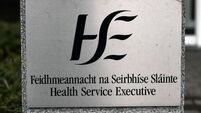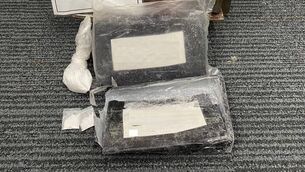Figures underestimate scale of problem
Aged in his 20s, it’s a sobering statistic.
He was nearly a casualty himself of what is almost a silent plague, spreading its tentacles wider and deeper across the country.
“I lost nearly five stone at one stage and took two brain seizures, ended up in hospital and nearly died,” said the Wexford man.
He said it was his body’s reaction after he suddenly stopped taking heroin and tablets in an effort to get on a treatment programme.
But others were not so lucky: “Four or five of my close friends have died and about another 15 other people I was using with are after dying from a range of substances, mostly heroin.”
It’s a grim testament to the savage impact heroin has had on places like Wexford town. New research seen by the Irish Examiner has placed a conservative figure of 253 active heroin users in the county, the highest in the southeast. And that, according to author, Professor Catherine Comiskey, is an underestimate.
“From our data regarding heroin, there has been a pretty constant increase of about 20% every year,” said Paul Delaney, coordinator of The Cornmarket Project in Wexford town. “We had three clients on heroin in 2001. We have 57 at the moment and possibly 65 at the end of this year.
“But we are well aware that this is only a small section of what’s out there. Professor Comiskey said 253 as a minimum. That would be a pretty accurate estimate based on our experience. It’s, as she said, a conservative figure.”
He said gardaí had told them the heroin situation in Wexford had “mushroomed over the years”. He said they only had a local garda drug unit in the last two years.
Mr Delaney, who worked in Merchants Quay Project in Dublin in the 1980s, said it generally took five or six years of heroin use before people looked for help.
“In Wexford, we are reaping the seeds sown in the early 2000s, people who are at it say six years. I think we are really seeing the first big wave of it now.”
The garda prosecution figures for heroin show the same upward trend. There were seven cases in the Wexford/Wicklow division in 2002, reaching a height of 37 in 2007 (last figures available).
Mr Delaney said the age of heroin users is falling. “ In 2001, we were seeing people in their early 30s. Now we see young users, 22-23, and anecdotally there are young people smoking heroin around the town.”
He said the size, in financial terms, of the local heroin market was huge. He said an active heroin user would go through 4-5 bags a day, at a conservative price of €25 a bag, giving a yearly sum in the region of €50,000.
“Of the 250 users, if you even say 150 are hardcore addicts, that adds up to a market of €8.25 million on heroin alone. That’s a huge amount of gathering money to feed that habit.”
Karl said, at his peak, he was using 8-9 bags a day and spending around €500 a week. He financed it by selling, a common practice among addicts. He is now off heroin and getting his life together, thanks to the work of staff at Cornmarket.
“By and large, the Dublin market is saturated. That’s not to say there isn’t some increase, but the big money to be made is now outside Dublin,” said Mr Delaney. “There is a huge, vibrant trade in Wexford, but the selling is more hidden than say Dublin.”
He said intimidation of users and their families was a growing issue. “It’s a big problem for us. As the heroin user becomes more entrenched in their use, they build up debts.”
He said one couple nearly broke up because of it. He said their son – a client of Cornmarket – had amassed huge debts and had got “seduced into selling”.
“The initially took out €40,000 to clear his debts. There had been threats on his life to the house. Then, the following year, they came back for more.”
He said the couple had agreed after the first time there would be no more pay outs, but the dad felt compelled to get out another €20,000 loan.
“It almost broke up their marriage,” said Mr Delaney.
The Comiskey report painted a grim picture across the southeast region, covering the counties of Carlow, Kilkenny, Wexford, Waterford, and south Tipperary.
Using a mathematical research method (see box) Professor Comiskey estimated a total of 893 users out of a population of 300,000 people. She said this was a conservative figure, as it was based on the number of opiate users in 2006.
“The estimate of 900 opiate users is most likely an underestimate, as the estimate was based on data from 2006 and that data from the treatment demand indicator has shown that numbers using heroin have continued to increase over the recent past,” said Prof Comiskey.
She was referring to the treatment data compiled under the National Drug Treatment Reporting System, operated by the Health Research Board. This shows a steady increase in the numbers of new opiate cases: 32 in 2002, 41 in 2003, 36 in 2004, 77 in 2005, 87 in 2006, 114 in 2007 and 118 in 2008. The significant rise in cases in 2007 and 2008 backs up Prof Comiskey’s assessment.
The Garda/CSO figures show the southeast region had the biggest increase in heroin prosecutions in the country between 2002 and 2007, jumping by over 2,000%, from seven cases to 144 cases.
Prof Comiskey said drug services told her heroin was the main emerging trend.
Chris Purnell, coordinator of the South East Regional Drug Task Force (SERDTF), agrees:
“Anecdotally, what we are hearing from communities and people on the ground is that an awful lot of people are using heroin and not availing of the services.”
He said counties such as Kilkenny and Tipperary, which didn’t have a heroin problem, were now reporting a “significant problem”. Mr Purnell, who runs the Farronshoneen Youth and Community Centre in Waterford city, said the typical profile of heroin users was similar to that in Dublin: “There is a socio-economic link. The main profile is early school-leavers, long-time unemployed, a lot of dysfunctional family backgrounds.”
Gardaí in the region accept the heroin problem has worsened over the years. “It’s fair to say it’s widespread,” said one garda source. “I’m not saying it’s at epidemic levels, but there’s no place that doesn’t have it.”
He said heroin addicts often move around, sometimes into new areas, and bring the drug with them, widening the circle of addicts further and further.
He said all districts now have their own drug unit. “All drug dealing is dealing no matter what, but we do target heroin. Heroin brings a lot of grief, not just to users, but innocent families.
“Obviously, heroin dealing also impacts crime figures. A lot of burglaries, particularly daytime break-ins, are by heroin addicts. They want money and jewellery, because they just want money for that day and the next.”
He said the gardaí’s main strategy was to hit the dealers: “We are targeting the main thoroughfares, Dublin to Carlow, from where it's dispersed to the rest of the region.”
He said addicts also travel to Dublin and buy enough for a week to sell to others or as part of a group of five or six addicts.
A major garda operation by the southeast region – backed up by the Garda National Drugs Unit – in Carlow last July, resulted in the arrest of 15 people for suspected heroin dealing. Similar operations were conducted last year in Waterford and Clonmel.
The garda source said heroin is trafficked into the region in small amounts and dispersed very quickly, making garda operations difficult.
Mr Delaney said the “most pressing” issue in the region was lack of treatment.
“The heroin trend is worrying, very worrying. Not only is the situation of concern, but also the lack of change in the situation from a services perspective. That is of particular concern.”
The Comiskey report said a range of services were needed:
* Detox Services: It said the lack of detox services was “consistently identified” by services and that even where they do exist, there were no agreements between detox services and GPs. It said local reports claimed that few GPs were willing to engage with drug users.
* Methadone services: The report said the lack of such services was a considerable gap and that the waiting list was in the region of 18 months.
* Needle exchange: It said the lack of services to provide clean injecting equipment was also a key problem
* Residential rehabilitation services: The report said the “dearth” of community detox facilities had implications for accessing residential rehab services, most of which require users to be already drug free.
The HSE told the Irish Examiner there were 66 people on a waiting list for methadone in the southeast as of August 1 last, with an average waiting time of a year.
A spokeswoman said new clinics (in addition to existing services in Waterford city and Carlow) would be in place in Wexford, Waterford and Kilkenny by the end of 2010.
The HSE spokeswoman said they were also “progressing plans” to provide a clinic in Gorey, Co Wexford.
“These clinics are essential,” said Mr Purnell. “We have a significant number on waiting lists and waiting one year for treatment is not appropriate. The national target is one month.”
He said the proposed clinic in Gorey was being blocked by the town council.
He is also exasperated at the delay in establishing methadone services in Wexford town and said he personally knew both pharmacists and GPs who were willing to prescribe methadone.
He said the HSE had not “acquitted themselves well” over its efforts to establish a clinic in Gorey. “There’s local and political opposition there. That’s not anything new. We were fighting those battles in Dublin 20 years ago. The HSE could go about it in different way... You have to bring people along.”
He said the area – like the entire region – lacked needle exchange services, meaning addicts were regularly sharing equipment, with all the resultant risk of spreading infectious diseases, such as hepatitis and HIV.
Mr Delaney said he is very concerned about the coming years, particularly given the 10% yearly cutbacks suffered by all community and voluntary groups in the last three years, with possibly more cuts to come.
“It’s easy to say glibly we are looking at more heroin use as a consequence of the economic situation, with more unemployed, more people depressed and feeling lost. I don’t know if that is going to happen. What I do know [is that] we did see in Dublin in the latter part of the 80s a huge upsurge in heroin use. We’re all holding our breath that that doesn’t happen. With the cutbacks we don’t have the facilities to cope.”












